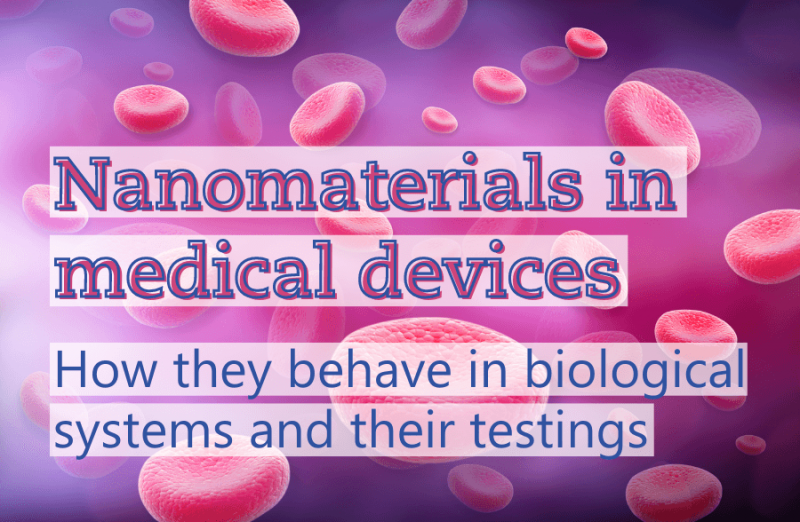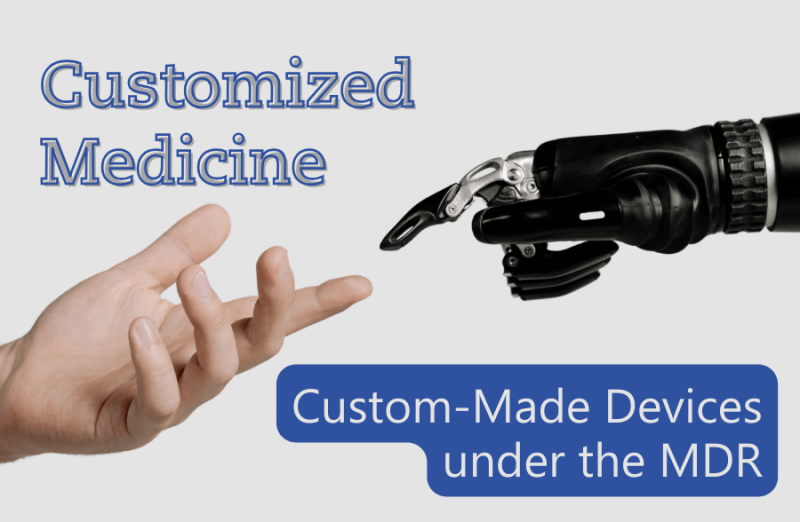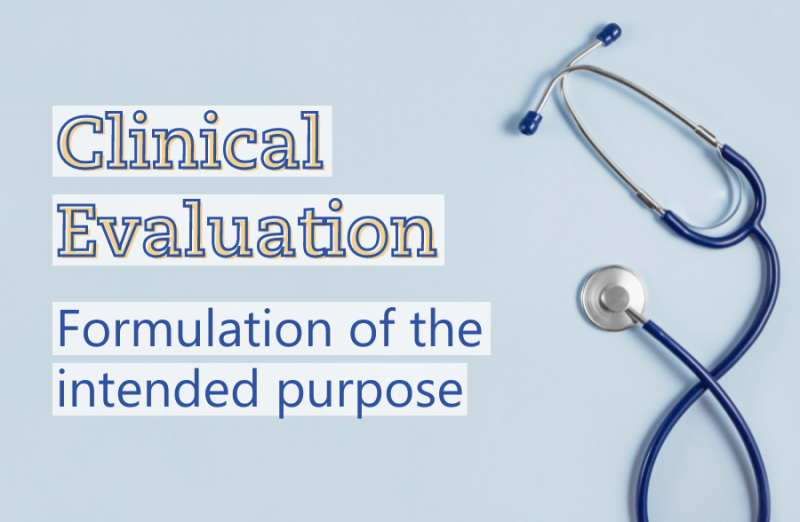Nanomaterials in Medical Devices – How they behave in biological systems, their testing, and pitfalls
23/10/2023
Earlier this year, we provided a concise overview of nanomaterials and their applications in medical devices. In that context, we introduced to the regulatory requirements of Regulation (EU) 2017/745 (MDR) and biocompatibility according to ISO 10993-1. Building upon this foundation, this continuation focuses on the specific considerations related to nanomaterials and their interactions within biological systems. These peculiarities need to be taken into account in order to plan suitable tests tailored to the application of medical devices and to be aware of potential pitfalls from the outset. Only in this way can nanomaterials be properly and meaningfully tested and subsequently evaluated to ensure the safety of your medical devices.
In the synthesis of nanomaterials, the possibilities are nearly limitless. Therefore, when considering their use in or as medical devices, careful consideration should be given to the materials chosen.
During these tests, often colorimetric or fluorescent measurement methods are used to measure cell viability, for instance. However, nanoparticles can lead to interferences due to their electrical charges and optical properties, such as the adsorption of dyes onto the nanomaterials, resulting in the incomplete metabolism of the dyes. Furthermore, nanoparticles can interact with nutrients present in the medium. All of this can potentially lead to distorted or false positive results. In this context, it is essential to find an appropriate test system before conducting the test, taking into account the existing characterization. Only in this way can relevant results be generated.Genotoxicity, Carcinogenicity, and Reproductive Toxicity
Nanomaterials, owing to their properties, can also act as mutagenic or clastogenic agents since they can reach sites within the cell and either directly affect DNA or indirectly, for example, by inducing reactive oxygen species. Before commencing the most common test for bacterial reverse mutation (Ames Test), the question should be asked, "Can the test provide me with the desired outcome?" In the case of the Ames Test, there is often the issue of not knowing precisely whether the nanomaterials can even reach the site of action, i.e., inside the bacterial cell, to exert an effect on DNA. Additionally, attention should be given to commonly used additives (e.g., S9 mix to simulate metabolism in the liver) and critically assessed, "Can my material even be metabolized in the liver?" Furthermore, proteins present in the medium can bind to the nanomaterials, influencing their uptake and reactivity within the test setup.Before considering in vivo experiments to address genotoxicity, carcinogenicity and reproductive toxicity, it is necessary to demonstrate that the nanomaterial can reach the relevant organs.These are just two examples of pitfalls that one can encounter when testing nanomaterials. As mentioned at the outset, thorough and thoughtful planning is imperative to obtain meaningful results.
Best Regards
Dr. Carolin Schilpp
Nanomaterials – various definitions
To facilitate re-entry into the topic, let´s review common definitions of nanomaterials:In accordance with the recommendation of the EU Commission 2011/696/EU, nanomaterials are defined as:- Naturally occurring, incidentally produced, or manufactured materials consisting of solid particles. These particles occur either independently or as identifiable constituent particles in aggregates or agglomerates. At least 50% of these particles meet at least one of the following conditions in the number size distribution:
- one or more external dimensions of the particles are in the size range of 1 nm to 100 nm;
- the particles have an elongated shape, such as rods, fibers, or tubes, where two external dimensions are less than 1 nm and the other external dimension is greater than 100 nm;
- the particles have a plate-like shape, where one external dimension is less than 1 nm and the other external dimensions are greater than 100 nm.
The Wonderful World of Nanomaterials
As evident from the definitions outlined above, there is not just "one nanomaterial," but many different variations. These variations can differ in terms of:- Surface chemistry,
- Composition,
- Physical properties, and
- Potential ligands.
- Surface charge,
- Surface functionality, achieved by attaching specific groups such as -NH2, -OCH3, or -COOH,
- Hydrophobicity, hydrophilicity, lipophobicity, or lipophilicity.
- Nanoshells (spherical nanoparticles consisting of a dielectric core covered by a thin metallic shell),
- Silica/Silicon dioxide,
- Iron oxide,
- Quantum dots,
- Polymer particles,
- Metallic nanoparticles to,
- Liposomes,
- Micelles,
- Dendrimers.
- Polymers,
- Small molecules,
- Nucleic acids,
- Proteins/peptides, or
- Antibodies.
In the synthesis of nanomaterials, the possibilities are nearly limitless. Therefore, when considering their use in or as medical devices, careful consideration should be given to the materials chosen.
How Nanomaterials Behave in Biological Systems
As previously elucidated, there are numerous ways to design nanomaterials, and each variation can exhibit different behavior depending on the environment. For example, a protein or small molecules may behave as expected in a test tube or in a test setup, i.e., in vitro. However, disillusionment may arise during subsequent in vivo testing, where the intended behavior is no longer observed. Why does this happen?In general, nanomaterials or nanoparticles pose unique questions due to their large surface area, which potentially allows for higher chemical reactivity. Additionally, there is the question of whether the small size enables the bypassing of otherwise effective barriers, such as the skin or lung epithelium, especially when such translocation is unintended.Nanomaterials are typically distinguished between their synthetic identity and their biological identity. As the name suggests, the synthetic identity refers to the state of the nanomaterial immediately after synthesis. At this stage, the material should possess all the intended properties and act as intended. However, this changes upon the first contact at the intended site of use, where initial interactions with the environment occur. These interactions manifest as binding with biomolecules such as proteins or lipids. This initial layer, known as the "hard corona," forms within seconds and is difficult to detach. Moreover, its composition remains largely unchanged after the initial formation. In addition, a "soft corona" also forms within minutes to hours, and its composition is more dynamic. The formation of the protein corona cannot be prevented without surface modification. Furthermore, through the formation of the protein corona, the nanoparticle acquires its biological identity, resulting in the specific behavior and, most importantly, a different pharmacological/biokinetic profile that deviates from its synthetic identity.Another point to consider is the state of the nanoparticle. It can exist as an individual particle or agglomerate, depending on its environment. The nanoparticle's state can also influence its physicochemical, biological, and pathobiological properties.It is of utmost importance to initially consider the intended application of the nanomaterial and the potential biokinetics involved. According to ISO 10993-1, the medical product must be classified based on the type of contact with the body. At this stage, it is crucial to carefully determine the nature of the contact: a nanomaterial that only interacts with intact skin may exhibit a completely different kinetic profile upon contact with mucous membranes. Additionally, the duration of contact and the exposure route must be precisely considered and characterized. Therefore, it is important that you obtain relevant, pre-existing information specific to your nanomaterial, following ISO 10993-1. If it is determined that an adequate database already exists and the identified risks can be deemed acceptable, according to ISO 14971 and ISO 10993-1, no further testing is required. However, the equivalence of the nanomaterial to the existing data must be demonstrated. Further information on this can be found in Chapter 4.4 of ISO/TR 10993-22 . Since nanomaterials have been relatively understudied, additional tests for characterization and subsequent toxicity or biocompatibility assessments are typically necessary.Characterization of Nanomaterials
Comprehensive characterization of the intended nanomaterials is indispensable. This characterization should encompass both the synthetic and biological identities, including all other relevant influences, such as cleaning and sterilization procedures. Only through such comprehensive characterization an adequate evaluation can take place, providing the basis for valid toxicity assessments and, consequently, for establishing biocompatibility. As previously emphasized, nanomaterials are substantially more demanding than conventional materials such as titanium. Therefore, a detailed characterization should be conducted directly during the development of the final medical device, reflecting how it will be applied in the patient.Within ISO/TR 10993-22, Chapter 5, the following aspects are considered:- Chemical composition,
- Morphology,
- Size distribution,
- Surface charge,
- Short- and long-term stability, and
- Imaging.
- Surface architecture (surface roughness, total surface area, and the number of surface protrusions in the case of incorporated nanomaterials).
- Porosity (size, structure, and distribution of pores or voids, as well as material density).
- Product geometry and the resulting mechanical behavior of the materials.
- Ionic strength.
- Concentration of ions present in the solution.
- pH value, including pH buffer system identification.
- Organic additives such as serum or antibiotics.
- Identity and concentration of dispersants if used.
Design Requirements – nanotoxicological studies
In addition to the characterizations presented thus far, nanotoxicological investigations play an equally important role. Therefore, toxicokinetic studies must be considered in the context of the toxicological risk assessment of medical devices containing nanomaterials. It is crucial to determine whether the nanomaterials used have the potential to be absorbed, distributed, metabolized, and/or excreted. After acquiring the relevant findings or even conducting studies in accordance with ISO 10993-16, a toxicological risk assessment may follow as part of the risk management process. Due to the unique properties of nanomaterials, this process is particularly challenging. Therefore, it is important to consider the following requirements when conducting testing:- Control of particle properties under various test conditions.
- Use of correct methods and study design.
- Adherence to established methods (EU NanoSafety Cluster – The NanoSafety Community) and created SOPs (Standard Operating Procedures; Nanommune, Quality Handbook, Standard Procedures for Nanoparticle Testing; Date: 2011), developed within EU research projects.
- Employing the correct dosage to establish an accurate dose-response relationship
- CAUTION: Avoid overloading the material.
- Utilizing an appropriate biological model.
- Including suitable positive and negative controls.
- Employing reference materials.
Pitfalls within testing
In addition to the points outlined above, there are further pitfalls that one can encounter within the respective tests. We present two examples:In vitro CytotoxicityDuring these tests, often colorimetric or fluorescent measurement methods are used to measure cell viability, for instance. However, nanoparticles can lead to interferences due to their electrical charges and optical properties, such as the adsorption of dyes onto the nanomaterials, resulting in the incomplete metabolism of the dyes. Furthermore, nanoparticles can interact with nutrients present in the medium. All of this can potentially lead to distorted or false positive results. In this context, it is essential to find an appropriate test system before conducting the test, taking into account the existing characterization. Only in this way can relevant results be generated.Genotoxicity, Carcinogenicity, and Reproductive Toxicity
Nanomaterials, owing to their properties, can also act as mutagenic or clastogenic agents since they can reach sites within the cell and either directly affect DNA or indirectly, for example, by inducing reactive oxygen species. Before commencing the most common test for bacterial reverse mutation (Ames Test), the question should be asked, "Can the test provide me with the desired outcome?" In the case of the Ames Test, there is often the issue of not knowing precisely whether the nanomaterials can even reach the site of action, i.e., inside the bacterial cell, to exert an effect on DNA. Additionally, attention should be given to commonly used additives (e.g., S9 mix to simulate metabolism in the liver) and critically assessed, "Can my material even be metabolized in the liver?" Furthermore, proteins present in the medium can bind to the nanomaterials, influencing their uptake and reactivity within the test setup.Before considering in vivo experiments to address genotoxicity, carcinogenicity and reproductive toxicity, it is necessary to demonstrate that the nanomaterial can reach the relevant organs.These are just two examples of pitfalls that one can encounter when testing nanomaterials. As mentioned at the outset, thorough and thoughtful planning is imperative to obtain meaningful results.
Conclusion
After learning about nanomaterials, you might have the impression that intentionally promoting their use within medical devices isn't advisable. Nevertheless, it is worthwhile to advocate for these special materials because, in part due to their unique properties or perhaps because of them, they play an incredibly important role. This is already true to some extent in the medical technology industry, and their significance is sure to grow in the future. While it is indeed a significant effort to gather all the necessary information in a meaningful way, it not only enhances the safety of your medical products but also fosters further innovations that can be of great benefit.Are you currently facing the challenge of characterizing and evaluating your medical device with respect to nanomaterials? Are there uncertainties about how to proceed effectively? Or are you in the process of developing a suitable testing strategy for the toxicological risk assessment and biocompatibility of your medical devices? Our experts are here to assist and work with you to develop individual solutions for your questions. We look forward to your contact for a non-binding and free initial consultation.Best Regards
Dr. Carolin Schilpp
 |
| Dr. Carolin Schilpp |
| Biological Safety Expert Regulatory Affairs & Technical Documentation |
| Connect on LinkedIn |
| carolin.schilpp@metecon.de |



